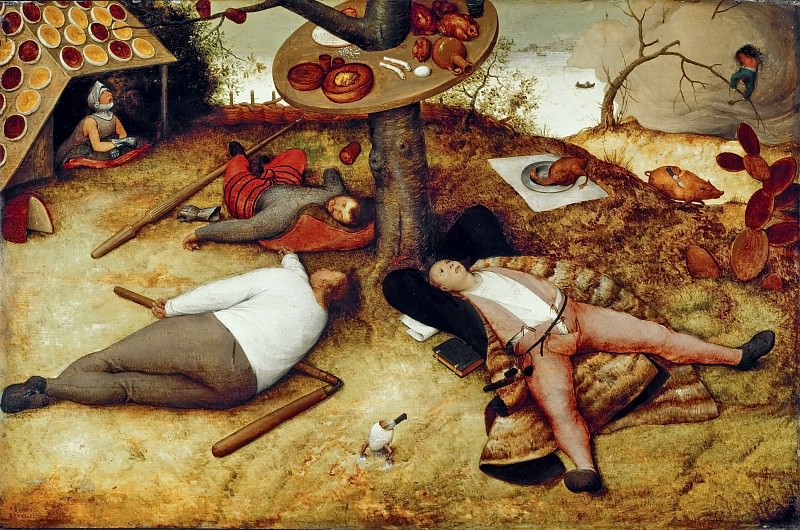The Land of Cockaigne Pieter Brueghel The Elder (1525-1569)
Pieter Brueghel The Elder – The Land of Cockaigne
Edit attribution
Download full size: 3570×2363 px (3,5 Mb)
Painter: Pieter Brueghel The Elder
Location: Alte Pinakothek, Munich.
Bruegel was a master of satire. More than once in his works one could find a hidden chuckle in relation to Dutch society. Thus, Bruegel’s painting "The Land of the Slackers" also concentrates a satirical spirit. The artist mocks the vicious society, resenting the fact that it does nothing to improve its existence. In the left corner of the painting, the author left his signature, dating the work to 1567.
Description of Peter Brueghel’s "Land of the Lazy"
Bruegel was a master of satire. More than once in his works one could find a hidden chuckle in relation to Dutch society. Thus, Bruegel’s painting "The Land of the Slackers" also concentrates a satirical spirit. The artist mocks the vicious society, resenting the fact that it does nothing to improve its existence.
In the left corner of the painting, the author left his signature, dating the work to 1567. In fact, it is very rare to find out the exact year of a painting, as not all artists date their work.
"The Land of Lazybones" is a fabulous place. It is a country made popular by European fairy tales, in which it has been described more than once. It is a place where milk rivers flow and the shores are acidic.
The first time that there is a country where no one does not do anything, but only eats candy, was written in a poetic tale by Hans Sachs. The author wrote it in 1536, but it was published only 10 years later. Perhaps it was it that became the basis for the artist to write his famous painting. In general, the tale has a lot in common with the picture painted by the artist.
At the same time, each of the characters in the picture belongs to a different class of society. With this, Bruegel showed that all equally do nothing: on the floor and sleeps a knight, and a soldier, and a peasant, and even a schoolboy. In addition, the author makes fun of the fact that they are all lazy people who are used to sitting around doing nothing all the time.
However, despite the fact that the picture has many features in common with the fairy tale, it still has some original characteristics. Therefore, it is a mistake to think that Bruegel painted it based only on the description from the fairy tale. On the contrary, he added something of his own, which makes the painting even more original and unusual.
Кому понравилось
Пожалуйста, подождите
На эту операцию может потребоваться несколько секунд.
Информация появится в новом окне,
если открытие новых окон не запрещено в настройках вашего браузера.
You need to login
Для работы с коллекциями – пожалуйста, войдите в аккаунт (open in new window).




















You cannot comment Why?
The painting The Land of Cockaigne by Pieter Bruegel the Elder depicts a satirical fantasy world where earthly desires are easily fulfilled, but at the cost of sloth and gluttony.
In the foreground, three men lie asleep, exhausted from their pursuit of pleasure. The figure on the left, dressed in a white shirt and brown trousers, rests his head on a farm tool, suggesting that even manual labor is a burden in this land of plenty. To his right, another man in red and gray attire sleeps soundly, his spear carelessly discarded. The third man, in pink trousers and a white shirt, lies on a thick fleece, his book fallen to the ground, indicating neglect of intellectual pursuits.
Looming above them is a large table supported by a tree, laden with an abundance of food: roasted meats, pastries, and eggs. This represents the effortless availability of sustenance and gratification. From the roof of a nearby hut, what appear to be roasted chickens and pigs wander freely, ready to be eaten. A solitary figure in a nuns habit gazes up at the food-laden roof, perhaps contemplating these easy delights.
The background further emphasizes the idleness and indulgence of this world. A pig with a knife stuck in its back walks towards a diner, seemingly offering itself for consumption. A bird pecks at the bottom of a mans thigh as he sleeps, reinforcing the theme of easy consumption without effort. The overall atmosphere is one of exaggerated abundance and passive enjoyment, where no effort is required to satisfy ones needs.
The subtexts of the painting are potent critiques of human vices: